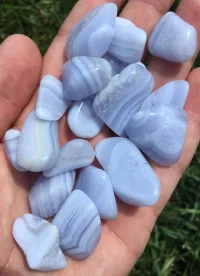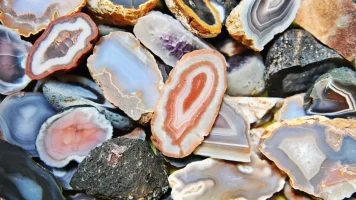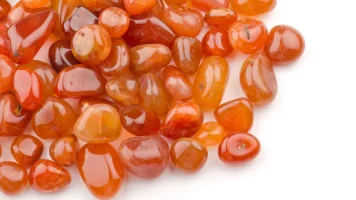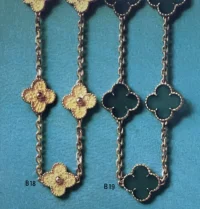I too would be curious to learn more about blue agate potentially fading. I’m tagging @allanrvj as I recall he has previously written several informative posts about the materials (hope he is ok with me tagging him) and in case he has insights.
You are using an out of date browser. It may not display this or other websites correctly.
You should upgrade or use an alternative browser.
You should upgrade or use an alternative browser.
Blue Agate Fading?
- Thread starter lynne_ross
- Start date
TPF may earn a commission from merchant affiliate
links, including eBay, Amazon, and others
More options
Who Replied?I remember reading that VCA carnelians turn dark over time. I haven’t purchased one (though I would love to!) because I’ve seen two cases where it was worn daily and they turned from pretty red to dark brown in color.
The jade thread is pretty interesting to read about stones in general. From what I recall, the stone can change in color and translucency with regular wear (sweat, oxidation). That is like a rabbit hole just talking about jades in that thread.
The jade thread is pretty interesting to read about stones in general. From what I recall, the stone can change in color and translucency with regular wear (sweat, oxidation). That is like a rabbit hole just talking about jades in that thread.
@sunshineshiney said she wore it 24/7 on and off over the past several years. I am guessing that would expose it to a decent amount of water and soap, shampoo etc. maybe blue agate turns darker no matter what. I will have to see what mine looks like. It has seen very little wear as I only wear WG if I can help it.Oh no I'm not saying it can't change color, but usually it doesn't happen until some prolong exposure of different elements, just like how the article stated. That's why I asked @sunshineshiney how she normally maintain her BA pieces. I know many people are used to cleaning their pieces with just tap water and soap knowing agate is quite hardwearing and 'water-safe', but the hardness and pH in the water can certainly cause some damage to the stones (and even metals), especially from frequent exposures. I used to do that too but only use distilled water to clean my jewelry pieces (and appliances) nowadays just to be safe.
Ahh my bad, totally missed that part! Yeah water and soap may've affected it. But tbh, it doesn't look all that bad, although most people are drawn to BA because of the vibrant color. I would be interested to find out if others share similar experience with their BA pieces as they're on my wish list still, and I definitely prefer a vibrant shade of blue over a darker/muted one.@sunshineshiney said she wore it 24/7 on and off over the past several years. I am guessing that would expose it to a decent amount of water and soap, shampoo etc. maybe blue agate turns darker no matter what. I will have to see what mine looks like. It has seen very little wear as I only wear WG if I can help it.
I too would be curious to learn more about blue agate potentially fading. I’m tagging @allanrvj as I recall he has previously written several informative posts about the materials (hope he is ok with me tagging him) and in case he has insights.

we have to remember that blue agate, as VCA calls it, is a dyed stone, i.e. agate doesn't really come in that bright shade of blue. the real "blue" agate is what VCA calls "Chalcedony" which, in standard gemology or in the trade is more commonly called blue lace agate. that one is the undyed version of agate.
blue lace agate:

here's what natural agate typically looks like. note the milky tones, banding, and muted colors:

side note: what VCA calls "carnelian" is not really true carnelian but agate dyed red. it is difficult to find carnelian stones that vivid shade of red, although such stones do occur, because ordinary carnelian is typically a milky orange with a lot of banding. moreover, true red carnelian is often included, i.e. has many "impurities", and doesn't resemble the very clean or very bright red stones VCA tends to use.
sample of true red carnelian where you can see inclusions that appear as "veins":

ordinary or common carnelian:

anyway.
dyeing agate stones is an acceptable and longstanding gemstone treatment. it has been around since ancient Egyptian times, and then continued with the Greeks and Romans, and then the present times. the basic process is as follows:
- agate is boiled in a sugar solution (like honey or molasses) to open up the pores
- then it’s treated with iron salts or aniline dyes to achieve a blue color
- aniline dyes are used since they are not UV-stable and can fade over time if exposed to direct sunlight
- even some mineral-based dyes may degrade with prolonged UV exposure.
hope this little gemology detour was useful. open to questions or nerding out more if anyone’s interested
trivia: VCA used to offer green agate in the 70's
this pic is from 1973:


Last edited:
we have to remember that blue agate, as VCA calls it, is a dyed stone, i.e. agate doesn't really come in that bright shade of blue. the real "blue" agate is what VCA calls "Chalcedony" which, in standard gemology or in the trade is more commonly called blue lace agate. that one is the undyed version of agate.
Thank you for the tutorial! I think this is the first time I came across this discussion as I thought the stones were natural. Wasn’t the turquoise stones used by VCA natural?
For jade (esp those Grade A types), inserting dye or treating a stone is frowned upon, but VCA uses this practice?
Now I’m wondering, are the pink sapphire pieces like the VCA two butterflies natural or treated? I read it is natural. But brands like Bvlgari use treated gem stones from what I was told in their boutique.
This pretty interesting. The blue agate was released 5 years ago - under the pretext that this stone is more durable than the lapis or higher in the Mohr scale - making the BA stone more desirable. With pictures showing lapis holding up its color over the years and the BA dulling over time, this is pretty disappointing news.
I’m still surprised that BA is color treated though, but this would explain the translucency of the stones similar to what we see in a grade B jade bangle (green, translucent) I guess.
I’m still surprised that BA is color treated though, but this would explain the translucency of the stones similar to what we see in a grade B jade bangle (green, translucent) I guess.
okay let's go through this one by one:Thank you for the tutorial! I think this is the first time I came across this discussion as I thought the stones were natural. Wasn’t the turquoise stones used by VCA natural?
For jade (esp those Grade A types), inserting dye or treating a stone is frowned upon, but VCA uses this practice?
Now I’m wondering, are the pink sapphire pieces like the VCA two butterflies natural or treated? I read it is natural. But brands like Bvlgari use treated gem stones from what I was told in their boutique.
1. turquoise used by VCA is typically stabilized, which is an accepted treatment in the gem world. natural turquoise is quite porous and soft, so stabilization helps preserve the color and structure. this is usually done by immersing the stone in resin and using pressure or vacuum to bond it internally, then curing it with heat. it still looks natural, just more durable, because true natural turquoise is also prone to oxidation due to its copper content, which can cause the color to darken or shift to a greenish hue with exposure to air or skin oils. stabilization helps seal the surface and keep the stone looking vibrant for much longer
2. VCA doesn't currently use jade in its collections. in the past, they have very occasionally used nephrite jade (the cloudy, more muted jade), not jadeite (the jade that looks like emerald) and even that was quite limited (see the Rare Alhambra pieces thread). and yes, when they did use it, it was untreated. VCA is very strict about gemstone treatments, so you won’t find dyed or polymer-impregnated jade in their pieces
3. most pink sapphires used by VCA, like in the Two Butterfly collection, are likely heat-treated, which is a completely standard and accepted enhancement for sapphires, especially in fine jewelry (where Two Butterfly falls under). it improves color and clarity without adding anything artificial, and the treatment is permanent. VCA is very selective with gemstone quality, so even their treated stones are exceptional. they do use unheated stones in some of their exceptional high jewelry pieces (especially blues from Kashmir or Burmese pinks), but that’s often specified and come with six-digit euro price tags (at least).
I believe it wasn't 5 years ago but 7 years ago. there were already blue agate pieces as early as 2018 but were limited to 10-motif necklace and 5-motif bracelet. some people even thought that the 20-motif wasn't coming so they bought two 10-motifs.This pretty interesting. The blue agate was released 5 years ago - under the pretext that this stone is more durable than the lapis or higher in the Mohr scale - making the BA stone more desirable. With pictures showing lapis holding up its color over the years and the BA dulling over time, this is pretty disappointing news.
I’m still surprised that BA is color treated though, but this would explain the translucency of the stones similar to what we see in a grade B jade bangle (green, translucent) I guess.
Thank you for this! I love learning something new.okay let's go through this one by one:
1. turquoise used by VCA is typically stabilized, which is an accepted treatment in the gem world. natural turquoise is quite porous and soft, so stabilization helps preserve the color and structure. this is usually done by immersing the stone in resin and using pressure or vacuum to bond it internally, then curing it with heat. it still looks natural, just more durable, because true natural turquoise is also prone to oxidation due to its copper content, which can cause the color to darken or shift to a greenish hue with exposure to air or skin oils. stabilization helps seal the surface and keep the stone looking vibrant for much longer
2. VCA doesn't currently use jade in its collections. in the past, they have very occasionally used nephrite jade (the cloudy, more muted jade), not jadeite (the jade that looks like emerald) and even that was quite limited (see the Rare Alhambra pieces thread). and yes, when they did use it, it was untreated. VCA is very strict about gemstone treatments, so you won’t find dyed or polymer-impregnated jade in their pieces
3. most pink sapphires used by VCA, like in the Two Butterfly collection, are likely heat-treated, which is a completely standard and accepted enhancement for sapphires, especially in fine jewelry (where Two Butterfly falls under). it improves color and clarity without adding anything artificial, and the treatment is permanent. VCA is very selective with gemstone quality, so even their treated stones are exceptional. they do use unheated stones in some of their exceptional high jewelry pieces (especially blues from Kashmir or Burmese pinks), but that’s often specified and come with six-digit euro price tags (at least).
I didn’t understand why someone said they have a greenish hue turquoise piece. Now I get it. I was used to seeing dark blue and sky blue varieties.
Nephrite and jadeite - I haven’t seen these terms in a long time.
You know stones. ❤️
They told me Piaget and VCA use only natural stones for Turquoise (I was told Chopard doesn’t for their happy heart collection, the turquoise is recombined)Thank you for the tutorial! I think this is the first time I came across this discussion as I thought the stones were natural. Wasn’t the turquoise stones used by VCA natural?
For jade (esp those Grade A types), inserting dye or treating a stone is frowned upon, but VCA uses this practice?
Now I’m wondering, are the pink sapphire pieces like the VCA two butterflies natural or treated? I read it is natural. But brands like Bvlgari use treated gem stones from what I was told in their boutique.
- for pink sapphire I am unsure : I thought they used not heated sapphire in these brands, but I just asked at Watches & Wonders for Chanel watches which this year have many pink sapphire but they use heated sapphire for that purpose 😔
Last edited:
@allanrvj VCA is pretty clear that they do NOT use heat treated sapphires. It’s one of the reasons their pink two butterfly collection (amongst other non-HJ items) lack vibrancy. They are one of the very few jewelers who do not heat treat sapphires, which greatly increases their value and price.okay let's go through this one by one:
1. turquoise used by VCA is typically stabilized, which is an accepted treatment in the gem world. natural turquoise is quite porous and soft, so stabilization helps preserve the color and structure. this is usually done by immersing the stone in resin and using pressure or vacuum to bond it internally, then curing it with heat. it still looks natural, just more durable, because true natural turquoise is also prone to oxidation due to its copper content, which can cause the color to darken or shift to a greenish hue with exposure to air or skin oils. stabilization helps seal the surface and keep the stone looking vibrant for much longer
2. VCA doesn't currently use jade in its collections. in the past, they have very occasionally used nephrite jade (the cloudy, more muted jade), not jadeite (the jade that looks like emerald) and even that was quite limited (see the Rare Alhambra pieces thread). and yes, when they did use it, it was untreated. VCA is very strict about gemstone treatments, so you won’t find dyed or polymer-impregnated jade in their pieces
3. most pink sapphires used by VCA, like in the Two Butterfly collection, are likely heat-treated, which is a completely standard and accepted enhancement for sapphires, especially in fine jewelry (where Two Butterfly falls under). it improves color and clarity without adding anything artificial, and the treatment is permanent. VCA is very selective with gemstone quality, so even their treated stones are exceptional. they do use unheated stones in some of their exceptional high jewelry pieces (especially blues from Kashmir or Burmese pinks), but that’s often specified and come with six-digit euro price tags (at least).
They told me Piaget and VCA use only natural stones for Turquoise and pink sapphire (not heated sapphire). I just asked at Watches & Wonders for Chanel watches which this year have many pink sapphire but they use heated sapphire for that purpose 🥺
I am a bit surprised about that. I was under the impression that the sapphires VCA used in the small Frivole RG necklaces are unheated. Maybe this is disclosed in the appraisal papers they provide where carat weight, etc is disclosed?
I asked Cartier before about their sapphire pieces, and I was told theirs was also heated. Tiffany is also the same. I guess this is a normal practice.
Register on TPF! This sidebar then disappears and there are less ads!


